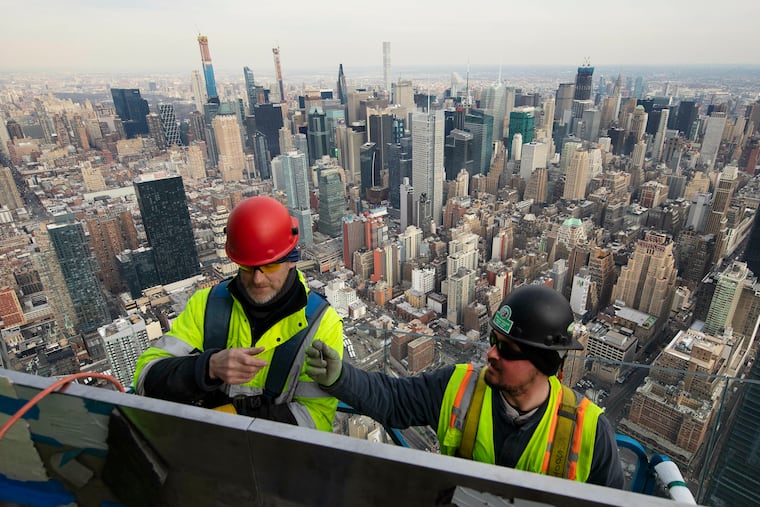Odds favor a double-dip recession, Moodys' Mark Zandi says. Which presidential candidate has the best plan?
Odds are high that the economy will be back in recession – in the so-called double-dip downturn when the next president is inaugurated, Moody's Mark Zandi said.

It’s probably safe to say there haven’t been two more different presidential candidates in American history than President Donald Trump and former Vice President Joe Biden. Their personalities and approach to governing are as different as night and day, as are most of their policies, including their proposals for the economy.
So, who has the better plan?
Before answering, we need some context regarding how the economy will be doing on Inauguration Day three months from now. It likely won’t be pretty. Odds are high that the economy will be back in recession — in the so-called double-dip downturn.
The first dip was more like a free-fall. It occurred last spring when the COVID-19 pandemic hit. Real GDP, which measures the value of everything we produce, fell a record-shattering more than 30% in the second quarter. The economy enjoyed a bounce this summer — GDP for the third quarter, which the government will release this coming week, will show a big gain. But that second dip is looming.
Particularly worrisome is the re-intensified virus, which we never contained. Much of the country reopened too quickly in the spring, and testing and contact tracing have been inadequate and not viable amid so much community spread. Now, infections are high and on the rise again as colder weather pushes us indoors, where even small gatherings appear to spread the virus.
More infections will mean a weaker economy, regardless of whether government officials decide to shut down businesses again. It is a false narrative that the spring recession was our own doing because we required businesses to close. The economy would have tanked no matter what as scared households pulled back on their spending and businesses their investment and payrolls. With infections on the rise in most of the country, the economy is sure to suffer.
Mounting rancor over the presidential election won’t help, especially if the election is close and contested, as Trump has threatened. Scenarios here are each darker than the next, but needless to say the longer it takes to decide a winner, and the greater the questions about the legitimacy of the winner, the greater the uncertainty and the more economic damage it will do. The collective psyche is already on the ledge. A messy election will almost surely push it over.
Also disconcerting is the inability of the Trump administration and Congress to come to terms on another fiscal rescue package. Lawmakers have been wrangling over another round of stimulus checks, more money for the unemployed, small businesses and the airlines, aid to hard-pressed state and local governments, and additional funds for schools and the health-care system.
Such help makes good economic sense, given the risks, and good political sense as lawmakers want to show voters they have their backs. Still, they have been unable to reach a deal. The pandemic-pummeled economy thus appears on its own until next year, when the new president and Congress take office.
So, which candidate has the better plan for getting the economy back on track? IMHO, the answer is Biden.
As president, Biden would go big on economic policy, significantly expanding government investments in infrastructure, education, health care, housing, and child and elder care. He would pay for this in part by raising taxes on corporations and the well-to-do — those making more than $400,000 a year — but the government would also need to borrow more, adding to the nation’s deficits and debt load.
In typical times, this policy wouldn’t get the economy very far, because it would lead to higher interest rates, which makes it more costly for businesses to invest and households to purchase a home or car. That happened after Trump cut taxes for businesses and the well-to-do earlier in his first term. Any economic benefit from the tax cuts was quickly washed out by the higher interest rates.
But a President Biden would inherit an economy that is far from typical — one that is in recession or close to it. Unemployment would still be extraordinarily high, inflation uncomfortably low, and interest rates would be near zero, where the Federal Reserve has said rates will remain until we are all back to work. Fed Chairman Jay Powell recently went so far as to say it would be riskier for lawmakers to provide too little fiscal support than too much.
This is a bright green light for Biden’s go-big strategy to get the economy back to full employment as quickly as possible.
The most direct beneficiaries of this policy will be lower- and middle-income households, minorities, and those with fewer skills and less education. These are the Americans working predominately in the retailing, travel, entertainment, transportation and health-care industries hit hardest by the pandemic. For more than a quarter-century, these same Americans have suffered the most financial hardship as incomes and wealth have become more lopsided.
To be sure, we will have to reckon with the nation’s fiscal problems. But that reckoning is for another day. Pressing on the fiscal brakes now while the pandemic is still raging would only undermine the economy and result in even bigger deficits and more debt. It is much better for government to go big until we are on the other side of the pandemic and the economy has a clear path to full employment.
That’s what Joe Biden proposes to do.
Mark Zandi is chief economist for Moody Analytics.